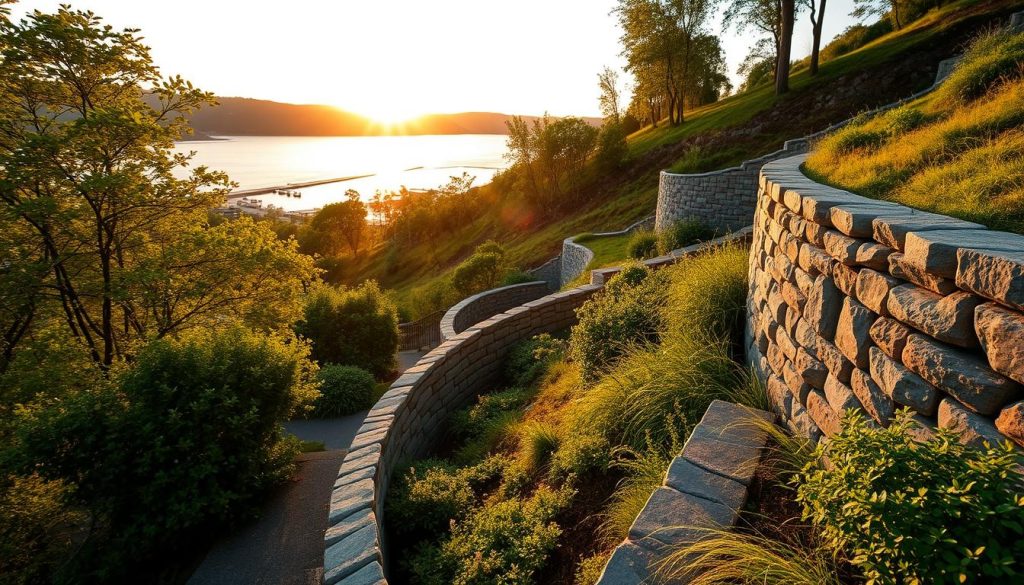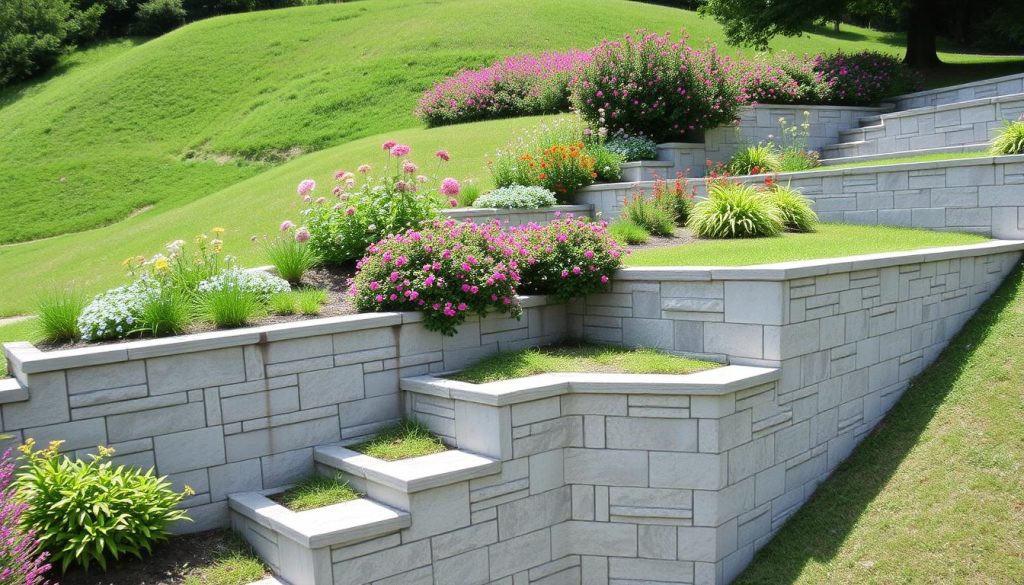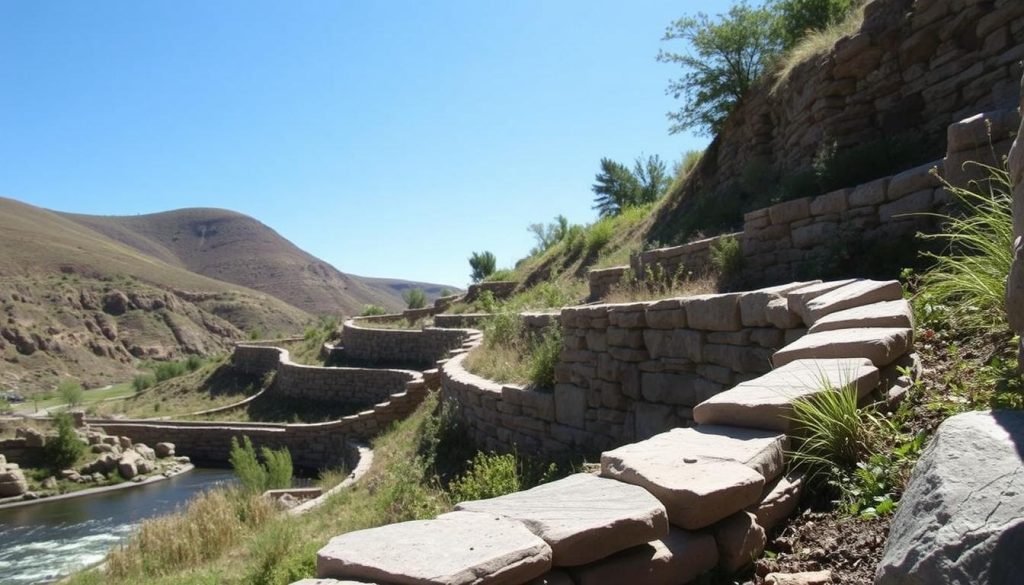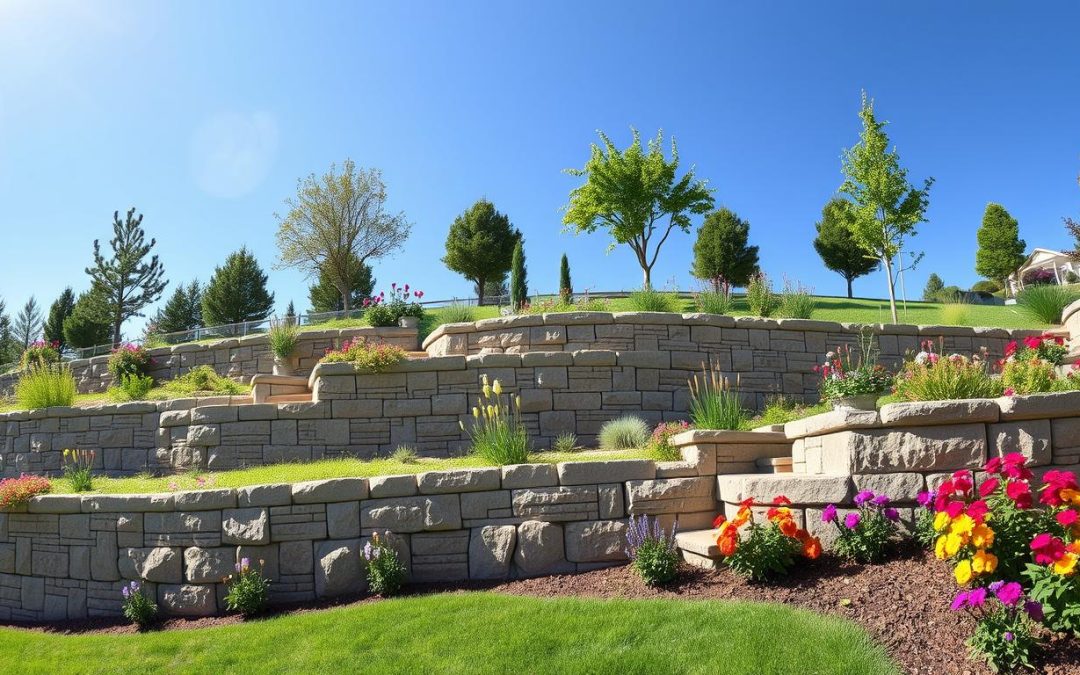Gravity retaining walls are very important in landscaping and civil engineering. They keep your outdoor spaces safe and stable. These walls work because of their weight, stopping soil from sliding.
These walls are used in many places. They help make terraces, level ground, and stop erosion. They also support roads, bridges, and trails. Using gravity retaining walls makes your landscape safe and beautiful.
Key Takeaways
- Gravity retaining walls provide a secure and stable solution for various landscaping and civil engineering applications.
- These walls rely on their weight and mass to resist lateral pressure, making them a key part of retaining wall systems.
- Gravity retaining walls can help prevent soil erosion and stabilize slopes, utilizing effective soil stability solutions.
- They are commonly used in civil engineering and landscaping projects, including the creation of terraces and support for roadways and bridges.
- Gravity retaining walls are a critical part of ensuring a stable and secure landscape, essential for projects using retaining wall systems and soil stability solutions.
- By using gravity retaining walls, you can create functional and beautiful outdoor spaces, making them a valuable addition to any project.
What Are Gravity Retaining Walls?
Gravity retaining walls stop soil and other materials from sliding. They use heavy stuff like concrete, stone, or blocks. This makes them strong and stable.
Building these walls needs careful planning. Things like soil type, wall height, and how steep the wall can be are important. Expert wall construction is key for these walls to work well. They help keep soil in place and protect landscapes and buildings.
Definition and Functionality
Gravity walls work best for heights up to 3m. They get too heavy for the ground if they’re taller. They’re good for low to moderate heights but can go up to 20 ft (6 m) without extra support.
Materials Used
Concrete, stone, and blocks are used for these walls. They help the walls stand strong against the pressure from the soil. Wet cast concrete walls can last 75-100 years, saving money for owners.
Design Considerations
Designing these walls needs thought about how long they’ll last and how to keep them up. The wall’s design lets it get taller without needing extra support. Thinking about these things helps make sure the walls are stable and work well.
Benefits of Gravity Retaining Walls
Gravity retaining walls have many benefits. They help with natural drainage and are cost-effective. They also need little upkeep.
These walls can stop soil erosion and protect your landscape from water damage. They make your outdoor spaces both functional and beautiful. This adds value to your property.
One big plus is they can act as erosion control walls. This keeps your landscape safe from soil and water harm.
A good design for a gravity wall can save you money. It doesn’t need deep digging or extra support.
These walls can also look good in your yard. They fit well with their surroundings. This makes them great for homes and businesses.
With a site-specific wall design, you can make a special outdoor area. It will meet your needs and look good too.
- Prevention of soil erosion and water damage
- Cost-effective solution for retaining walls
- Low maintenance requirements
- Ability to be designed to blend into surroundings
- Can be used to create functional and beautiful outdoor spaces
Gravity retaining walls are a top pick for landscaping. They offer many benefits and advantages.
Adding a gravity wall to your design can make a great outdoor space. It meets your needs and looks good. Plus, it’s a cost-effective retaining wall option.
Key Applications for Gravity Retaining Walls
Gravity retaining walls are used in many places. They help make outdoor spaces look good and keep soil from washing away. They also help keep slopes stable.
In homes, these walls can make terraces and level ground. They can stop soil from sliding down. For instance, a homeowner might use one to make a flat area for a garden or patio.

In big projects, like roads and bridges, these walls are key. They keep embankments strong and prevent erosion. They are important for keeping soil stable in these projects.
- Highway construction projects
- Urban infrastructure projects
- Landscaping and erosion control projects
- Waterfront structures and areas where water is present
Gravity retaining walls are very useful. They help keep soil stable and support many structures. By picking the right wall, people can make sure their projects are safe and stable.
Choosing the Right Location
When building structural retaining walls, where you put it matters a lot. You need to check the soil to make sure the wall stays strong. Experts look at the soil, wall height, and how it leans to pick the right wall.
It’s also important to know the local rules. Each place has its own rules for walls. Not following these can lead to fines or even taking down the wall. With the help of experts, your wall will be strong and follow local rules.

- Soil type and stability
- Drainage and water flow
- Local building codes and regulations
- Environmental concerns, such as erosion and sedimentation
By looking at these things and getting help from experts, your walls will be safe and last long.
Common Construction Techniques
Building erosion control walls involves several common methods. These include block, stone, and concrete walls. Each has its own benefits and drawbacks. The choice depends on the wall’s design and cost.
A good wall design is key to its stability and success. It involves checking the soil, following local rules, and picking the right materials. For example, concrete masonry units are solid and cost-effective. They help prevent soil erosion and keep the structure stable.

The construction method also affects the wall’s success. A well-made wall can last long and protect against erosion. By picking the right materials and method, you can build walls that are both useful and look good.
Maintenance Tips for Longevity
Keeping your Gravity Retaining Walls in good shape is key. Regular checks can spot problems early. Make sure the drainage systems are clear to avoid water damage.
Here are some tips for retaining wall care:
- Regular inspections to identify signs of damage or movement
- Vegetation management to prevent roots from growing into the wall
- Clearing drains and installing additional drainage solutions to ensure proper soil stability solutions
Healthy plants and grass help keep the soil in place. But, you must manage the plants well to avoid harm. For expert advice, reach out to Slaton Bros, a trusted retaining wall contractor.
By following these tips, you can make your Gravity Retaining Walls last longer. Regular care is important for their stability. So, don’t forget to take care of your retaining walls to keep your landscape looking great.
How to Incorporate Aesthetics
Designing structural retaining walls is all about looks. Expert wall construction makes them look good and work well. Natural stone finishes make your outdoor space beautiful.
Adding plants and greenery to your wall makes it look natural. Plants with deep roots hold soil, stopping erosion. This makes your outdoor space stunning and useful.
- Using plants with deep roots to help hold the soil in place
- Creating a tiered garden with multiple levels of plants and greenery
- Incorporating a water feature, such as a small fountain or stream, to add visual interest
These elements make your outdoor space beautiful and functional. With durable structures and expert construction, you’ll enjoy it for years.
Environmental Considerations
When making gravity retaining walls, think about the environment. Erosion control walls help stop soil erosion and protect nature. A wall design that fits the site helps it look natural.
For a wall that’s good for the planet, think about using gabions. These are wire baskets filled with rocks. They’re strong and can match many styles and budgets. A well-made wall can handle big loads and changes in the weather, staying strong for years.
Important things to think about for an eco-friendly wall include:
- Choose materials like gabions or recycled concrete that are good for the planet.
- Make a wall design that fits the site to keep its size down.
- Add features like weep holes or pipes to keep water away.
By thinking about these things and using smart materials, you can make a wall. It will support structures and help the environment.
Frequently Asked Questions
Let’s talk about some common questions about gravity retaining walls. First, how do you know if you need one? It depends on your soil, terrain, and if you have erosion or stability problems. If your yard slopes or is uneven, a gravity wall can help make it level and stop soil from washing away.
How long does a gravity retaining wall last? It really depends on the materials used. Brick, stone, and concrete walls can last 100 years or more with the right care. Wooden walls, on the other hand, usually last 25 to 40 years. A well-made gravity wall can last for decades, making your outdoor area look and work better.

